Ten days after we left Wickford Village in Rhode Island, we arrived at Riverview Marina in Catskill, NY. Catskill is about 20 miles short of Waterford, the eastern entryway to the Erie Canal. As famously proclaimed in the Erie Canal song, “Low Bridge! Everybody Down!” the canal is traversed by some 286 bridges and other structures. Boats and barges traveling the 338 mile canal between Waterford and Tonawanda, NY, where it connects with the Niagara River near Buffalo, cannot be more than 15’6” above the water. Any taller than that, and you’re going to hit something. Hence, “low bridge, everybody down!” And if the canal is engorged with rain, entire sections of the canal will be closed until water levels subside.
That low bridge clearance is of particular concern for sailboats. Most sailers 20 feet long or more have masts that stand at or above 20 feet. Gaviidae requires clearance of 58 feet. So we must dismantle the mast to navigate the canal. Marinas near either end of the Erie Canal offer mast lowering and raising services. Catskill marinas are where sailboats are serviced at the east end.
Loosing our Bearings
We didn’t expect to take 10 days, but an overnight on a mooring ball at Port Washington on New York’s Long Island turned into a five-day stay when I discovered BBs rolling around in the catch pan beneath the engine. We were two days out of Warwick Village. I found these little harbingers of trouble
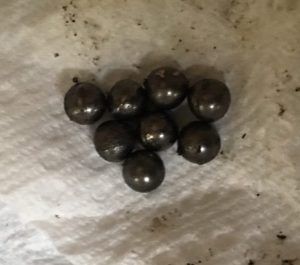
as I checked the oil, belts and wiring on our 71 horse Westerbeke diesel engine. Checking the engine before departure is a ritual instilled in me early on in my sailing career. It’s a habit that certainly paid off that morning. An investigation established that Gaviidae’s mechanical seawater pump was spitting bearing balls. Seeing bearing balls is not a good thing if you aren’t a spectator at a male strip club. I’ve never been in a male strip club as either a patron or a performer, but I quickly eliminated that likelihood, along with the alternator. That seawater pump is essential to cooling the engine. Losing the use of our engine while plying the East River to get around Manhattan to the Hudson River would have been problematic.
As it was, the balls were discovered and disaster averted. Unfortunately, the problem turned up on a Saturday morning; we had to wait until Monday to order a replacement pump. We paid for overnight shipment, but the UPS truck carrying our new pump was involved in a traffic accident. We did not get the pump delivered to us until Wednesday morning. I installed the new pump, got the alternator back in place and reconnected, and we were ready to go.
Glittering New York
Because of crazy but predictable currents and tides in approaches to New York City and in the East River, we motored out of Port Washington harbor at 2 a.m. to get favorable tides and currents. Our way was lit by a bright, nearly full moon. We hit Hell Gate—a notoriously nasty section of our route–at 3:30 that morning with just a couple of barges and tugboats sharing the waterway. Millions of tiny lights danced on the waters of the East River as the Big Apple sparkled in her slumber. I couldn’t tell if the city had been entertained at any of her male strip clubs earlier, but she was alluringly aglitter in her nightdress.
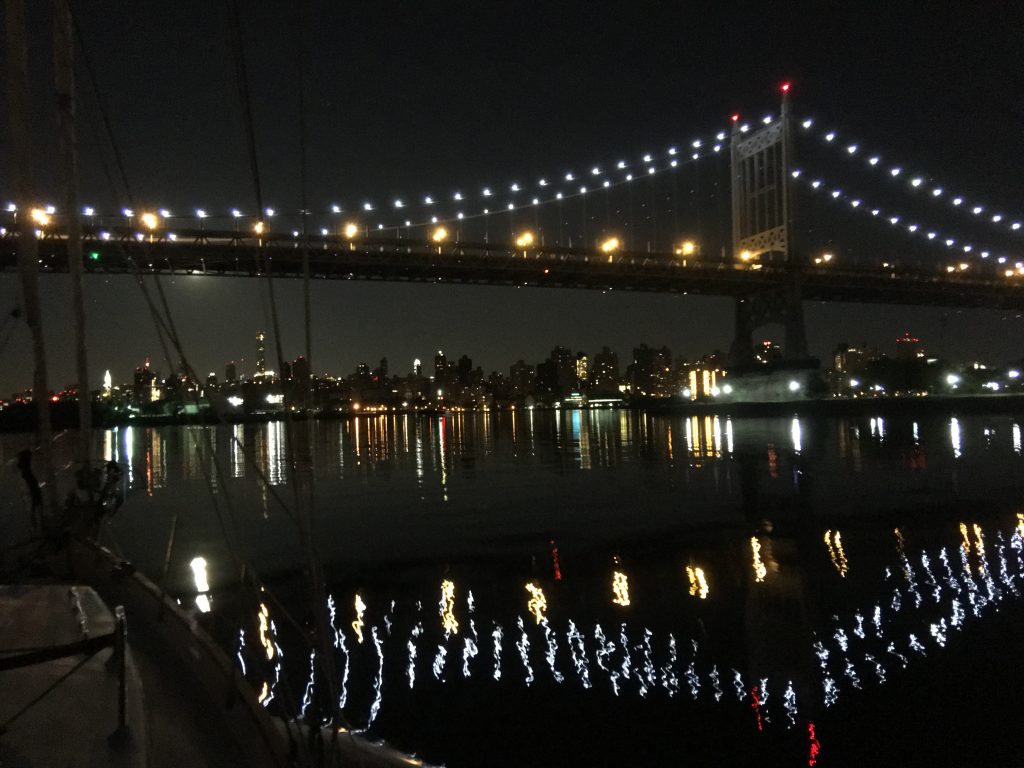
Passing the Battery on Lower Manhattan we spotted the Statue of Liberty in the first glint of sunrise just as that big moon sank behind it. We had already been dodging the first ferries between New Jersey and Manhattan when we passed under the George Washington Bridge on the Hudson River at 7:30 a.m.
The cruise up the Hudson was beautiful–fringed with lush greenery. We passed landmarks like the Palisade cliffs and Sing Sing prison. I didn’t hear any singing, so I belted out a refrain from “Born Free” for the benefit of the prison’s guests. They probably needed a break from the constant loop in their heads of “Folsom Prison Blues” every time a train rolled by—which was about every five minutes, it seemed.
That night we tied up at a state-run marina to take on fresh water and get our holding tank pumped out. After two nights on the hook and five on a mooring ball, we figured we shouldn’t push our luck with either end of that proposition. The fresh water and holding tanks should easily accommodate us for a couple of weeks, but this boat was new to us and we didn’t want to tempt fate. As it turned out, the marina dockhand was unable to get the pump-out equipment to work! That old black water would have to keep on rollin’. Less than a day from Catskill, it wasn’t a big issue: “And I ain’t got no worries/’Cause I ain’t in no hurry at all.”
Mast Down
The farther up the Hudson we cruised the more wild and scenic it became. Once we passed West Point the river significantly narrowed and became windy—as in no longer straight. We arrived at Riverview Marina in Catskill midafternoon, promptly got a pump out and fueled up. We tied up to the first finger pier and began derigging the boat, including removing and folding sails and loosening rigging. We also began planning the support structures for the mast, which would have to be laid down the entire centerline length of the boat.
Julie’s friend, Anne, arrived as we began derigging. She would be traveling with us on the Erie for an unspecified period. Anne is a sailing friend of Julie’s from her Women Who Sail adventures. She drove from Vermont to meet us in Catskill. We welcomed not only the company, but benefit of extra crew with boating and woodworking skills. Those hopes and expectations were dashed when she arrived bandaged and trussed up from a dirt bike crash. The accident left her with a cracked clavicle, nasty bruises, scrapes and burns. These injuries on top of others suffered during a sailing trip in the South Pacific a few months earlier left her with limited strength and capacities, not to mention pain. She did arrive with some nice wine and plenty of salty banter, so it was all good.
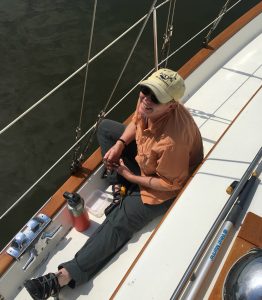
Derigging, designing and building and lowering and securing the mast took four days. Some of that slow progress was due to the excessive heat that descended on us. More of it was pondering sufficient support for the mast.
Ice Cream!
A couple days in I heard a faint tinkle of bells that I recognized as the signature sound of an approaching ice cream truck! Now ice cream trucks are not a common thing in rural western South Dakota, and therefore not part of my upbringing. But I watched enough Leave It To Beaver or something to know what an ice cream truck should sound like. We raced to the street to flag down the driver, exulted in our rich icy treats and persuaded the driver that future rounds should include the marina. Sure enough, he came through the next afternoon. I think enough of his frozen confections were consumed that day to build a mast cradle with Popsicle sticks.
The three cradles we built were inspired by the mast cradles other sailors were building for their boats, made mostly with two-by-fours and -sixes screwed together with woodscrews. We also adapted a castoff cradle abandoned by sailors heading down the Hudson after coming off the canal. Mast cradles are customized to every boat according to the practical considerations of the size of the boat’s mast, foredeck and cockpit, as well as the engineering skills and aesthetic conceits of each boat’s master. There were plenty of mast and cradle comparisons up and down the docks with mast debaters holding forth about creative cradling and sufficient furler support.
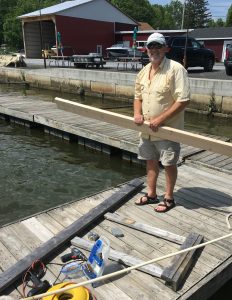
We sourced some elements of our structures from a pile of old lumber tossed pell-mell behind the marina office. I strapped a support onto the bow pulpit rails and Julie and I concocted a structure that straddled the dinghy davits behind the cockpit. Ratcheting straps and the weight of the mast would keep the cradles upright. The cradles themselves wouldn’t likely earn any engineering awards, but they were sturdy and practical and would nicely support the mast and all its tentacles. The alternating lime green and bright orange straps added a festive Caribbeanesque flair. Steel drums and a couple coconut-laden palm trees—under 15’ 6”–would have completed the effect. Our structures and their placement would also allow us to keep the canvas roof over the cockpit to protect the crew from sun and rain.
The mast was raised clear of the deck by a large crane, which then lowered it onto our cradles. Final lashing and strapping was completed with cushioning provided by thick foam letters from a children’s bag of cutouts. The foam was donated by another boat who had extra pieces. We also strapped letters to the lower spreaders which reached over the lifelines about head height. We happened to use the letters W and H for “Watch Head.” The strategically placed foam letters would save us all from contusions and concussions as we moved fore and aft to lock and dock in coming days.
Once sails were lashed to the deck before and aft of the center cradle, we were ready to set out for the mouth of the Erie Canal at Waterford early the next day.
Low bridge, everybody down/Hudson River moon won’t you keep on shinin’ on me.
##
June 13, 2017 Catskill NY 42°12.654’N 73°51.398’W 256.4 Nautical Miles

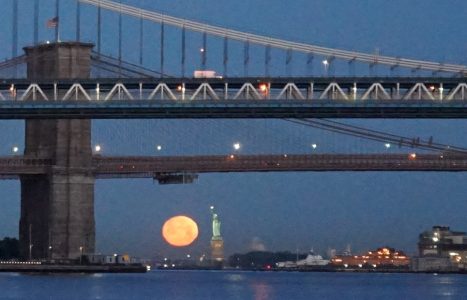
Hi, Dan and Julie! It’s 4AM and I can’t sleep. Reading this was totally diverting. Thanks! Love, Lynne
Great writing with interesting details. Looking forward to the next blog edition.
Thanks, Ilona. Getting to and thru DeWitt’s Ditch as a shakedown cruise proved to be a bigger challenge than we anticipated. More to come soon now that we’re racing across Lake Erie to get to Goderich, some much needed tune ups at the Gozzard Yachtspa, then some much needed R&R in the North Channel. Sorry we missed you in Door County.